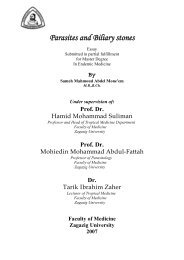E. Coli
E. Coli
E. Coli
You also want an ePaper? Increase the reach of your titles
YUMPU automatically turns print PDFs into web optimized ePapers that Google loves.
Seven out of eleven (63.63%) E.coli isolates from layers were<br />
sensitive to ampicillin. Comparable results were obtained by Abd-El-<br />
Mawla (1998) who recorded moderate sensitivity percentage 50% for<br />
ampicillin against E.coli isolates. Higher percentages 89.6% and 96.7%<br />
were obtained by Gundogan et al.,(2006) and Khoshkhoo and<br />
Peighambari (2005) respectively, meanwhile other studies on E.coli of<br />
poultry showed that the resistance of isolates to ampicillin were 82%<br />
and 74.24% as recorded by Mishra et al.,(2002) and Hui and Das<br />
(2000) respectively.<br />
Six out of eleven(54.54%) E.coli isolates from layers were<br />
sensitive to gentamycin. This result agreed with the result obtained by<br />
El-Ghamdi et al.,(1999) who compared antibiotic resistant E.coli<br />
isolates to ampicillin, chloramphenicol, gentamycin, spectinomycin,<br />
tetracyclin , trimethoprime spectinomycin, tetracyclin and sulpha-<br />
methazole and found it ranged from 57% to 99.1%.<br />
Seven out of eleven (63.63%) E.coli isolates from layers were<br />
sensitive to sulphamethazole/ trimethoprime. This result is nearest to<br />
the result of El-Sayed et al.,(2001) who stated that sulphamethazole<br />
/trimethoprime resistance percentage was 73.3% and disagreed with<br />
Blanco et al.,(1997) who stated that resistance percentage was 67%.<br />
86
















